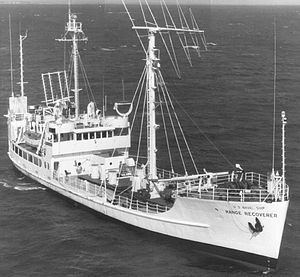Name USS Range Recoverer Acquired by the Navy April 1960 Tonnage 499,000 kg Builder Whitestone | Laid down date unknown Length 54 m Tons burthen 848,200 kg | |
 | ||
Namesake A ship stationed in the anticipated landing area of a space vehicle Completed for the U.S.Army in 1944 as FS-278 In service 22 June 1960 as USNS Range Recoverer (T-AG-161) | ||
USNS Range Recoverer (T-AG-161/T-AGM-2/YFRT-524) was a missile range instrumentation ship responsible for providing radar and/or telemetry track data on missiles launched from American launch sites.
Contents
She was built during World War II as U.S. Army U.S. Army FS-278, and was acquired by the U.S. Navy in 1960 as miscellaneous auxiliary and was converted into a missile tracking ship. She continued her missile tracking until being placed out of service in 1972, at which time she was reclassified range tender YFRT-524, and eventually scrapped in 1974.
U.S. Army
FS-278 was built for the Army in 1944 by the Wheeler Shipbuilding Corp., Whitestone, New York. FS-278 was a Coast Guard-manned Army vessel commissioned at New York on 25 November 1944 departing New York on 17 December 1944, for the Southwest Pacific where she operated at Peleliu, Palawan, etc. during the war. Command transferred to LT A. W. Engle, USCGR on 25 June 1945. From 28 August until 20 September FS-278 transported General Douglas MacArthur's defense planning staff for the Philippine Islands. She was decommissioned 3 October 1945.
U.S. Navy
The ship was acquired by the Navy in April 1960; converted by Pacific Ship Repair, San Francisco, California; and placed in service with the Military Sea Transportation Service (MSTS) as T-AG-161 on 22 June 1960, Capt. John Strom in command.
Missile tracking activities
Named Range Recoverer on 12 July, she reported to the Navy's Pacific Missile Range in August 1960. At the time Navy had command and control authority over nearly all Vandenberg Air Force Base launches and the range. On 27 November she was reclassified a missile range instrumentation ship and designated T-AGM-2. She is equipped with telemetry, data processing and radio instruments as well as recovery facilities to retrieve nose cones.
Manned by a Civil Service crew of the Military Sea Transportation Service, Range Recoverer served first as a telemetry and recovery ship on the Pacific Missile Range where she launched, tested, and evaluated the Regulus missile. In July 1962 Range Recoverer shifted to Little Creek, Virginia, to support the NASA facility at Wallops Island, Virginia. NASA technical party operators used on board equipment, including helix antennas, data recording systems and a communications suite with direction finders to locate and recover payloads. There she replaced two T-1 tankers, Dumont and Whitlock, damaged during a storm.
Since that time, into 1970, Range Recoverer operated out of Little Creek primarily between Wallops Island and the splash down area near Bermuda.
Other services provided
During the mid-sixties the ship traveled to Greece for coordinated research on a solar eclipse and was visited by the Greek royal family. NASA, assisting other government agencies, has also loaned Range Recoverer to the Virginia Institute of Marine Science and the Woods Hole Oceanographic Institute, to conduct oceanographic surveys off the coast of Virginia.
Final disposition
Range Recoverer was placed out-of-service in 1972 and reclassified as range tender YFRT-524. She was struck from the Navy List (unknown date) and sold for scrap 1 November 1974.
